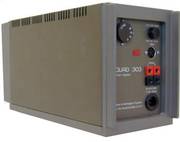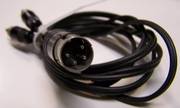Ein QUAD 303 Test vom März 1975 in "Studio Sound"
Der QUAD 303 war der transistorisierte Nachfolger des legendären QUAD II Röhren-Endverstärkers. Dieser Röhren-Endverstärker war speziell für die Elektrostaten ESL57, eine Entwicklung von Mr. Peter Walker, entwickelt worden.
Der 303 sollte die gleichen Qualitäten haben wie der QUAD II und das hatte er auch. Röhrenfans sind da völlig anderer Ansicht, konnten das aber nie beweisen, immer nur behaupten. Jedenfalls wurde der 303 fast nie warm oder gar heiß, selbst in kleinen Diskotheken mit angeschlossenen TANNOY Boxen nicht. Und kaputt bekam/bekommt man diesen 303 auch nicht.
Im März 1975 hat der Engländer Hugh Ford den Endverstärker QUAD 303 auführlich beschrieben, jedenfalls so gut er es konnte (oder wollte). Andere Tests aus anderen Magazinen folgen noch.
Von dem QUAD 303 sollen angeblich 94.000 Stück hergestellt worden sein. Nach den Schilderungen des Wolfgang Hasselbach, der den Deal mit der BRAUN LE1 einfädelte, war die kleine Firma QUAD dazu gar nicht in der Lage. Wolfgang Hasselbach wußte, was es heißt, Stückzahlen zu produzieren.
Wenn man heute im ebay die Hersteller nach Angeboten durch geht, müsste der QUAD 303 bei fast 100.000 Stück sehr viel häufger auftauchen. Da ist also nachträglich einiges - aus gewissen monitären Eigeninteressen - geschönt bzw. verklärt oder aufgehübscht worden.
.
Die 4-Pol DIN Eingangsbuchse
Wer hatte das verzapft ? Eine DIN- Anschluß-Buchse, die nicht 3-polig und auch nicht 5-polig war und deren benötigte 4-Pol Stecker man nirgendwo kaufen konnte. Eigentlich war das ein dicker Flop, der so nicht hätte vorkommen dürfen. Zu der Zeit waren international fast ausschließlich Cinch-Buchsen der Standard oder schon die 6,3mm Klinkenbuchsen.
.
THE QUAD 303 POWER AMPLIFIER
By Hugh Ford im März 1975
.
Seine Beurteilung :
IT HAS ALWAYS struck me that many engineers in the recording business regard the Quad 303 as a domestic amplifier and have not bothered to read the specification or really investigate its possibilities.
Ein abweichender Sprachgebrauch
The mechanical "construction" (im US Englisch ist eine construction eine Baustelle !! z.B "under construction") of the amplifier is to a very high standard, with the connectors and other facilities completely recessed such that dropping the amplifier on to the floor is more likely to damage the floor than the amplifier. In fact the rear of the amplifier comprises a substantial cast heatsink with the output transistors mounted between the fins, and the front of the amplifier is a further casting which is joined to the tear casting by a solid chassis.
Die Eingänge/Ausgänge
The input/output connectors, mains voltage selector and fuse are located on a plate set into the front panel which also accommodates a mains pilot lamp. Mains input is by a miniature Bulgin three-pin socket which is associated with a rotary-plug type voltage selector covering the standard European and American input (main-) voltages.
Overall amplifier protection is by a 20mm fuse which is also located on the front panel and identified by the symbol T2A which in fact means a 2A Time lag fuse and is the symbol in accordance with British Standards 415:1972 and 4265:1968.
Personally I find this identification confusing, and I apologise to Quad for accusing them of not identifying the fuse rating on the type 50E amplifier which I previously reviewed, when they had in fact included a similar identification.
Inputs are by means of a single four-pin DIN socket which does not have its connections identified on the front panel, and outputs consist of two pairs of 4mm banana sockets which are not on the standard 19 mm spacing.
Hugh Ford is hating DIN plugs
These two features could be improved, as the screw terminal combined with a 4mm socket on 19mm spacing is a much more convenient device and I have a peculiar hate for wiring-up DIN plugs [You're not alone-Ed]. There is however plenty of space to accommodate alternative types of plug and socket, including enough space to mount XLR type plugs if one so wishes.
The accessibility of the components for servicing is really excellent, as each of the two channels has its own printed board which can easily be hinged out from the bottom of the amplifier. A third printed board is occupied by the dc voltage stabiliser which feeds both channels, the series stabiliser transistor and the output drive transistors being mounted on the rear heatsink.
There are a total of five preset controls in the circuitry, the first of which adjusts the stabilised dc voltage and the remaining four being used to set the quiescent current and the operating point of each of the two channels.
Output power and distortion
While the Quad 303 is basically designed as a stereo amplifier with a rating of 28W into 16Q or 45W into 8Q for each channel, it may also be used as a single channel amplifier with a rating of 90W into either 4Q or 16Q by running the channels in series or parallel.
These configurations can be accomplished with very little modification and mean that the amplifier offers more than adequate power for most applications where a high quality monitor amplifier would be used.
The measured output clipping point at 1kHz was found to be as in the following table, and was found to be constant when either or both channels were operating and also constant when the incoming mains voltage was reduced until the incoming mains voltage fell to -6.7% on the nominal setting. This is of course a great advantage for many purposes, as with an unstabilised power supply the output power potential would have fallen by 13.4%.
.
Load resistance Output clipping point at 1k Hz
| Load | Channel One | Channel Two |
| 16 Ohms | 28W | 28.1W |
| 8 Ohms | 48W | 48W |
| 4 Ohms | 34.8W | 28.6W* |
*4 Ohm loads are outside the manufacturers' specification - so far as distortion performance is concerned, but these figures exceed the performance indicated in the manufacturers' graphical data.
.
Die Verzerrungen gemessen
The distortion performance of the amplifier was measured in terms of second and third harmonic components at 1kHz and at 10kHz at various power levels, because it is inevitably difficult to measure total harmonic distortion at very low levels in the presence of any hum and noise. The following figures demonstrate an exceptionally good performance which puts the Quad 303 into the very best class of amplifiers:
Because both channels demonstrated a very similar distortion performance, the results (below) are only quoted for the average channel, as is also the case with the following figures for intermodulation distortion as measured by the SMPTE method with 50Hz and 7kHz tones in the amplitude ratio 4:1.
Intermodulation Equivalent peak output into 80 distortion
45 W 1.95%
4.5W 0.028%
450 mW 0.02%
45 mW 0.012%
Clearly the above intermodulation distortion figures indicate a high standard of performance, and while the distortion at 45W is not all that it might be, reduction in output power to 40W gave a figure of 0.03 per cent and investigation around the rated 45W output showed the expected steep rise in distortion that is normally associated with transistorised amplifiers, once the rated output is exceeded.
.
Output power into 8Ohm Distortion
| Output power into 8Ohm | Distortion at | 1kHz | Distortion at | 10kHz | |
| in Watt | Second | Third | Second | Third | |
| 45 W | 0.014% | 0.016% | 0.046% | 0.07% | |
| 4.5 W | 0.014% | 0.009% | 0.056% | 0.034% | |
| 450 mW | 0.012% | <0.005% | 0.04% | 0.032% | |
| 45 mW | 0.006% | < 0.005% | < 0.008% | 0.005% | |
| Testgear residual | 0.005% | 0.005% | 0.008% | 0.005% |
.
Die Amerikaner und ihre Rechteckwellen (-signale)
The application of fast risetime "squarewaves" gave a measured slew rate of 2.5 V/us with a rise time of 6us when working into resistive 8Ohm loads: The addition of 2uF of capacitance in parallel gave the waveform shown in fig. 1 which does not show any tendency towards instability and shows a well controlled overshoot.
Likewise, tone burst testing did not show any visible distortion during recovery from severe overload, even when the amplifier was over-driven by 10 dB with both channels operating.
.
Frequency response and noise
Fig. 2 is a plot of the power response at a 1kHz output of 45W into 8 Ohms, and also includes the frequency response at 10dB below this output level. Over the audio frequency band the two responses are virtually identical, and for practical purposes there is no point in exceeding this performance which has a healthy roll-off outside the audio frequency band.
The manufacturers' specification states that amplifier noise is 100dB below full output, without stating what (if any) weighting network was used for measurement. The measured noise in the output with the input shorted and the output loaded with 8 Ohms, relative to 45W per channel, was found to be as follows:
| Channel One | Channel Two | ||
| Unweighted | 2 Hz to 200k Hz | -94.4 dB | -92.3 dB |
| Unweighted | 20 Hz to 20k Hz | -97.3 dB | -98.6 dB |
| 'A' weighted | -101.5 dB | -102.3dB |
Mains hum and its harmonics was well below the above noise and there was no sign of any rf in the output.
.
Inputs and outputs
The measured input sensitivity at 1kHz for an output of 45W into 8Q was 464mV for the left channel and 483mV for the right channel, a reasonable difference of 0.34 dB, while the input impedance of both channels was within 0.5% of 20kQ.
Der kleine Dämpfungsfaktor
Fig. 3 shows the relation between output impedance and frequency, which is fairly typical of capacitor coupled outputs but perhaps offers a rather small damping factor for some loudspeakers.
The measured inter-channel crosstalk with one channel delivering 45W into 8Q and the input to the other channel shorted, was almost constant at a level 62dB below 45W from 40Hz to 20kHz.
Other aspects
The final matter which may be of interest is the phase shift characteristic of the amplifier; this is shown in fig. 4 for frequencies between 2Hz and 200kHz (with thanks to B&K Laboratories for letting me borrow the demonstration model of their new phase meter -a delightful instrument) which confirms that the amplifier should be inherently stable and does not exhibit excessive phase shift at audio frequencies.
As with other mains-operated equipment, the Quad 303 was inspected for electrical safety in terms of British Standard 415:1972 and I am pleased to report that no faults were found in this direction.
Summary
This is a fine amplifier with unusually good distortion performance, good signal-to-noise ratio and a flat frequency response in the audio spectrum with what I regard as a desirable roll-off outside the audio spectrum.
Every parameter was within the manufacturers' specification which, while it is not particularly detailed, does provide the basic performance figures which the majority of manufacturers quote. The only area where I have some reservations is that the potential damping factor is on the small side and might be troublesome with some designs of loudspeaker.
Having regard for the 303's performance as a stereo amplifier rated at 45W per channel into 8Ohm, or as a mono amplifier capable of delivering 90W into 4Ohm or 16Ohm, the Quad offers very good value for money and has quite adequate output capability for the majority of high quality monitoring uses.
reprinted from Studio Sound.
MANUFACTURERS' SPECIFICATION
These figures relate to either channel, with or without the other channel operating.
Power output and distortion (with unrestricted bandwidth):
70 Hz <0.03%, - 700 Hz <0.03%, - 10k Hz < 0.1%.
At any level up to 28W 16Ohm load. At any level up to 45W 8Ohm load.
Frequency response:
-1 dB (ref 1k Hz) at 30 Hz and 35k Hz into 8Ohm.
-1 dB (ref 1k Hz) at 20 Hz and 35k Hz into 16Ohm.
Output source impedance: 0.3O in series with 2000 [if and 6 [i H.
Input level: 0.5V rms for 30W into 16Ohm.
Input impedance: 22 kQ in parallel with 60 pF.
Hum and noise: -100 dB below full output.
Interchannel crosstalk: 30 Hz to 1k Hz better than 60 dB. Input load 1 kQ.
Stability: Unconditionally stable with any load.
Power input: 100 to 125 or 200 to 250V 50 to 60 Hz.
40-200W depending on signal level.
Weight: 8.2 kg.
Dimensions (w x h x d): 120 x 159 x 324 mm plus 38 mm for connectors).
Other applications: For music in the home the amplifier is suitable for use with speakers of all impedances between 4 and 25 Ohm. For high level sine wave duty and other special applications involving reactive loads the load impedance should be not less than 8Ohm.
Manufacturers: The Acoustical Manufacturing
Co. Ltd, 30 St Peter's Road, Huntingdon.
FIG. 2 QUAD 303 POWER AMPLIFIER POWER RESPONSE AND FREQUENCY RESPONSE PEN: 1mm/S,PAPER: 1mm/S
FIG. 4 QUAD 303 POWER AMPLIFIER PHASE SHIFT AT 1W INTO 8Q PEK :200mm/S, PAPER: 3mm/S





